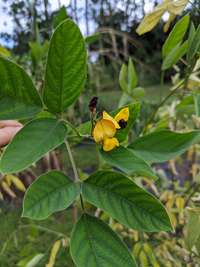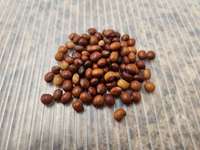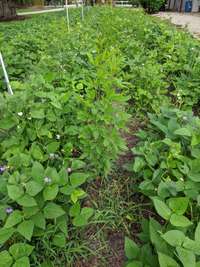
Figure 9. ‘Georgia-1’ leaves and flower. Source: ECHO Staff
Among our multi-purpose legumes, the ECHO Global Seed Bank offers a special variety of pigeon pea (Cajanus cajan) to include in small-farmer systems worldwide. ‘Georgia-1’ flowers and forms seed pods mostly at one time (semi-determinate) and flowers regardless of day length (day-length neutral). It is of shorter duration (65 to 100 days to flowering) and grown mostly for its pulse grain.

Figure 10. Seeds of ‘Georgia-1’ pigeon pea. Source: Emma Mudd
‘Georgia-1’ has common features of C. cajan with its strong and penetrating taproot supporting its woody stem and leafy biomass. The deep taproot of C. cajan helps it get moisture from deep in the soil profile, making it resistant to drought and able to recycle nutrients from deeper in the soil. Growing up to 1.6 m, it has trifoliate, compound leaves with typical legume flowers and seed pods (Figure 9). Seeds of ‘Georgia-1’ are varying shades of brown (Figure 10).
Uses
Farmers cultivate pigeon peas worldwide for their pulse grain, pods, fodder, green manure/mulch. They use it as both a sole and intercrop, and in rotation with other crops. This versatility lends itself to inclusion in climate-smart agriculture systems.
The ‘Georgia-1’ variety, with its semi-determinate growth habit, integrates well into existing farming systems, helped by C. cajan’s drought resistance. It offers a yield of pulse grain, enabling quicker crop rotations and more productive fallows while contributing some biomass for fodder and/or mulch (Motis, 2021). When selecting the right Cajanus cajan variety, consider these traits using the referenced guide provided in EDN 150 [http://edn.link/gwrjww].
Climate and soils
The FAO’s (2024) general agroecological requirements for pigeon peas help determine environments where ‘Georgia-1’ variety could prove suitable for planting.
‘Georgia-1’ can withstand the lower range of temperatures found seasonally in the southeast US. C. cajan grows at altitudes up to 3000 m and in the tropical highlands where lower temperatures are also found. C. cajan grows well in semi-arid areas as well as wet and dry tropical and subtropical climates. While C. cajan withstands temperatures ranging from 10°C to 45°C, its ideal temperature is between 18°C to 38°C. Precipitation requirements range from 400 to 4000 mm, with ideal annual rainfall of 600 to 1500 mm (FAO, 2024).
C. cajan grows best at a neutral pH but can tolerate a range of 4.5 to 8.4. It grows best in medium to light-textured soils (sandy to silt loams) but also grows in coarse (sands) or heavy (clay) soils (FAO, 2024). It is susceptible to waterlogging (Sheahan, 2012) which can hinder nodulation and encourage root diseases. The yield of ‘Georgia-1’ is greatly influenced by soil fertility; infertile soils yield only 1681 kg/ha, while fertile soils can yield up to 5044 kg/ha of dry beans (Phatak, 2006).
Cultivation
Sow seeds 3.5 cm deep; seedlings will emerge in up to 3 weeks (Sheahan, 2012). Early growth is slow and does not compete with weeds or the primary crop. However, once established, the plant exhibits rapid growth. Its deep taproot and extensive root system enhance drought tolerance, allowing it to thrive in semi-arid conditions with minimal moisture.

Figure 11. ‘Georgia-1’ intercropped with cowpea at the North America Regional Impact Center Farm. Source: Emma Mudd
Common intercrops include cowpea (Vigna unguiculata) (Figure 11) and mung bean (Vigna radiata) and pearl millet (Pennisetum glaucum; Sharma et al., 2010); black gram (Vigna mungo) and maize (Zea mays) (Pandey et al., 2013); and peanut (Arachis hypogea; Jat and Ahlawat, 2010). Adjust the spacing of each crop and report your results on ECHOcommunity.com.
Researched spacing recommendations vary between ‘Georgia-1’ and pigeon pea in general. An equidistant spacing of ‘Georgia-1’ at 1 m yielded 2764 kg/ha of grain and another equidistant spacing of 3 m yielded 2281 kg/ha (Tegegnea et al., 2012). Panda et al. (2020) found that a medium-duration variety of C. cajan yielded best at a spacing 120 X 30 cm.
When using ‘Georgia-1’ for biomass and grain, remember that it is a semi-determinate, short duration variety. It will respond to pruning by continuing to grow, but as its leaf production and potential flowers reach a maximum, growth tapers off. Therefore, to balance grain yield and biomass, prune early before flowering. You may get only one cutting before significantly affecting grain yield.
C. cajan responds to organic amendments in addition to basic fertilizer. Studies show that applying 5 t/ha of farmyard manure (Jat and Ahlawat, 2010; Pandey et al., 2013) or substituting that with 2.5 t/ha of vermicasts (Pandey et al., 2013) increased yield. In Georgia, added phosphorus increased ‘Georgia-1’s growth in phosphorus-deficient soils where native rhizobium inoculates the plant (Phatak, 2006).
‘Georgia-1’ flowers in 65 to 100 days; harvest when seed pods mature, turning brown and drying out, before they burst open on the plant.
Pests
‘Georgia-1’ is tolerant of leaf pests like fall armyworm (Spodoptera frugiperda), and velvetbean caterpillar (Anticarsia gemmatalis) which feeds on flower buds in North America (Phatak 2006).
Pod borers (Helicoverpa armigera) create small holes and leave excrement (frass) as they bore into pods and feed on developing seeds. The Maruca Pod Borer (Maruca vitrata) larvae feed on flowers, leaving webbing and damaged pods by their feeding.
The Adzuki bean weevil (Callosobruchus chinensis) and the cowpea weevil (Callosobruchus maculatus) are frequent bruchid pests of stored Cajanus cajan grain (Ragul and Manivannan, 2024). Ragul and Manivannan (2024) in their review mention neem (Azadirachta indica) preparations (seed kernel extract [5%] with soap solution [0.1%]) or neem seed oil at 1 ml per 100 g of seeds, tobacco (Nicotiana tabacum) and moringa (Moringa oleifera) powders to control bruchids in stored pulses. Always consider the end use of stored grain (seeds or comestibles) when applying botanical treatments.4
When growing and storing significant quantities of ‘Georgia-1’ pay attention to local bruchid pests before storing seed. Bruchids frequently glue eggs onto seed pods, and first instar hatchlings penetrate seed pods with little visible damage. When harvested, the rapidly multiplying insects in the infested seeds cause significant damage.
Consult local extension services for additional pests and effective biological and cultural controls and methods.
References
Food and Agriculture Organization (FAO) GAEZ Data Portal. 2024. Plant Search Form. Search terms <Cajanus cajan> then view <view crop> and <data sheet>. [Accessed 10 May 2025] URL: https://gaez.fao.org/pages/ecocrop-find-plant
Jat, R.A. and I.P.S. Ahlawat. 2010. Effect of organic manure and sulphur fertilization in pigeonpea (Cajanus cajan)+ groundnut (Arachis hypogaea) intercropping system. Indian Journal of Agronomy 55 (4): 276-281. ICRISAT open access repository. https://oar.icrisat.org/view/icrisatcreators/Jat=3AR_A=3ANULL=3ANULL.date.html
Motis, T. 2021. Factors to Consider when Selecting a Pigeon Pea Variety. ECHO Development Notes no. 150.
Panda, P. K., P. M. Mohapatra, S. S. Bal, I. O. P. Mishra, N. Senapati, R. K. Panigrahi and A.M. Prusti. 2020. Effect of Nipping and Row Spacing on Crop Growth and Productivity of medium duration pigeonpea. Int. J. Curr. Microbiol. App. Sci. 9(08): 1832-1837. doi: https://doi.org/10.20546/ijcmas.2020.908.209
Pandey, I. B., S.K. Singh, and S. Tiwari. 2013. Integrated nutrient management for sustaining the productivity of pigeonpea (Cajanus cajan) based intercropping systems under rainfed condition. Indian Journal of Agronomy, 58(2), 192-197. DOI:10.59797/ija.v58i2.4171
Phatak, S. C. 2006. Pigeon pea, a new grain legume for production in Georgia and the Southeast. Research Impact Report. University of Georgia College of Agricultural & Environmental Sciences. https://www.caes.uga.edu/research/impact/impact-statement/547/pigeonpea-a-new-grain-legume-for-production-in-georgia-and-the-southeast.html
Ragul, S. and N. Manivannan. 2024. Bruchid a Serious Pest on Pulse Crops: Its Control Measures and Breeding Advancements: A Review. Agricultural Reviews. Vol.45 (2): 290-296. doi: 10.18805/ag.R-2307.
Sharma, A., P. Rathod, and K. Basavaraj. 2010. Agronomic management of pigeonpea (Cajanus cajan L.) based intercropping systems for improving productivity under rainfed conditions. Karnataka J. Agric. Sci.,23 (4):570-574.
Sheahan, C.M. 2012. Plant guide for pigeonpea (Cajanus cajan). USDA-Natural Resources Conservation Service, Cape May Plant Materials Center. Cape May, NJ. 08210.
Tegegnea, F., Singh, S.B., Dusejac, D., E. Ekanemd, and R. Bullock. 2012. Pigeonpea as a Niche Crop for Small Farmers. Journal of Food Distribution Research. 43(1). https://doi.org/10.22004/AG.ECON.139459